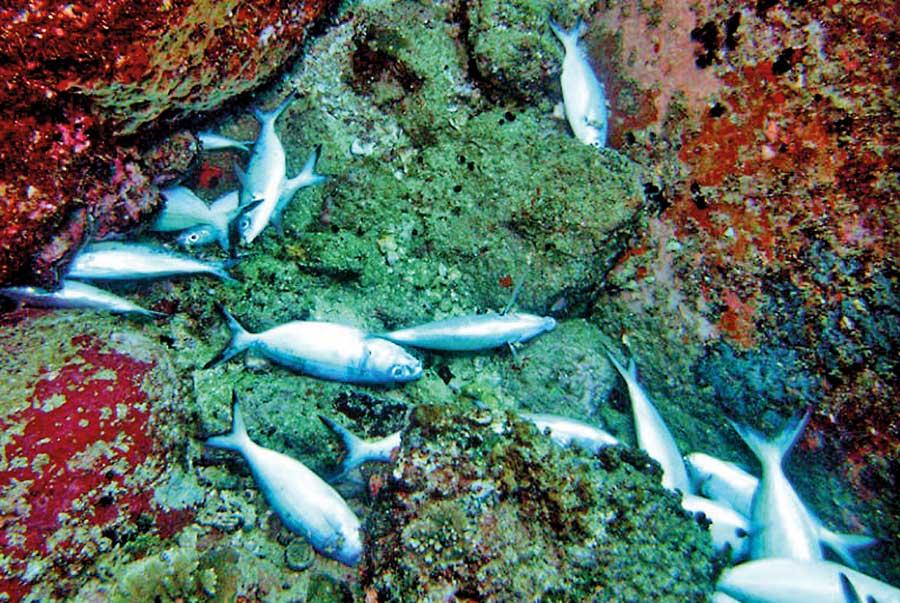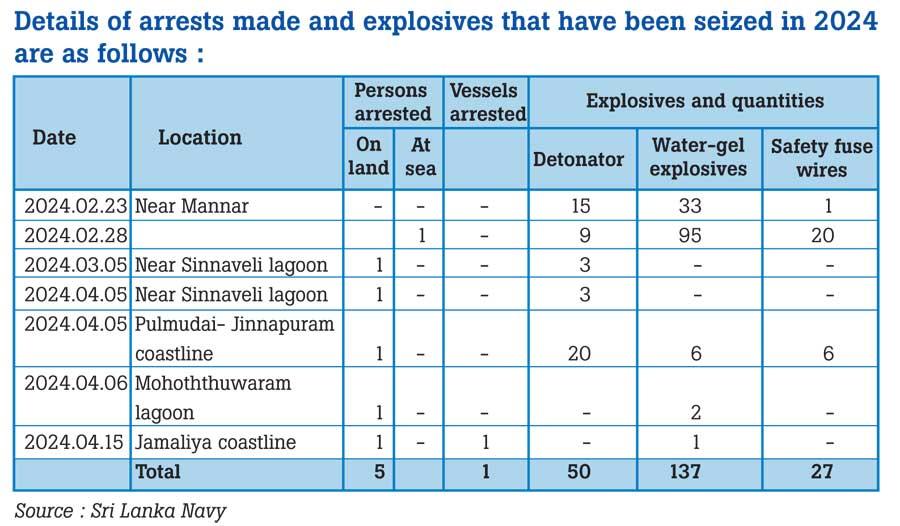Reply To:
Name - Reply Comment

Unable to swim with a ruptured swim bladder, fish injured by an underwater concussive blast slowly sink to the bottom of the sea. (Image courtesy of Dharshana Jayawardena)
In 2020, six people from Rameswaram, Tamil Nadu, India were arrested by the Ramanathapuram Police for attempting to smuggle around 5000 explosive materials similar to gelatin sticks, purportedly for blast fishing. According to a Times of India report, one of the groups was contacted by a fisherman from Sri Lanka. Police investigations revealed that the suspects were anticipating gold or other valuable items instead of money in exchange to the smuggled explosives. While many such explosives including detonators are being manufactured in Tamil Nadu and are being smuggled by boats to be distributed among Sri Lankan fishermen, incidents of dynamite fishing or blast fishing along the Sri Lankan coastal belt has increased by manifold over the recent past, posing a threat to unique maritime ecosystems.
attempting to smuggle around 5000 explosive materials similar to gelatin sticks, purportedly for blast fishing. According to a Times of India report, one of the groups was contacted by a fisherman from Sri Lanka. Police investigations revealed that the suspects were anticipating gold or other valuable items instead of money in exchange to the smuggled explosives. While many such explosives including detonators are being manufactured in Tamil Nadu and are being smuggled by boats to be distributed among Sri Lankan fishermen, incidents of dynamite fishing or blast fishing along the Sri Lankan coastal belt has increased by manifold over the recent past, posing a threat to unique maritime ecosystems.
History of blast fishing
Hundreds of dead fish lying at the bottom of the sea bed off the Trincomalee coastline were caught on camera recently, proving the devastating effect of blast fishing. Speaking about the history of dynamite fishing in Sri Lanka, Arjan Rajasuriya, former Marine biologist at the National Aquatic Resources Research and Development Agency (NARA) said that dynamite fishing was done in a small scale using a catamaran during the 1950s and 1960s.
“People put dynamite in areas where larger shoals of fish would gather and later go about picking floating fish in the sea. Blast fishing is common off the shores of the southern coastline including areas such as Rumassala and Trincomalee. It later expanded to shipwrecks where people would use dynamite to collect scrap iron from shipwrecks off Galle for example in places such as Gintota,” said Rajasuriya.
But divers and marine experts observe that blast fishing has expanded into an organized operation. “Blast fishing is now more prevalent off the shores of Gulf of Mannar, Arippu, Silavaturai and Vankalai, Vidathalthivu, the Northern side of Mannar, Punkudithivu – between Delft and Punkudithivu, Nilaveli, Kuchchaveli, near Fort Fredrick, Batticaloa, Vakarai, Mankerni, a little bit of dynamiting happens in Kalmunai, and then again around Hikkaduwa, Gintota and Boossa. The issue with blast fishing is that nobody sees these incidents as it happens some 4-5km away from the coastline,” he added.
An attempt to maximize the catch
Explaining how blast fishing is being done, Rajasuriya said that fish aggregate around rocks, shipwrecks and reefs that rise above the seabed. “So fishermen tend to do dynamite fishing around these areas to maximize the catch. What people usually do is use a purse sein, a type of net that operates like a purse to catch a large number of fish. In this type of net, the top is left afloat while the bottom has been pursed. Dynamite is used when there’s a larger shoal of fish and there’s a danger of the net breaking due to struggling fish. When dynamite is used it stuns the fish and it’s the vibration that kills the fish. Fish have a specific organ in them called the swim bladder. It basically acts like a buoyancy compensator in scuba diving which allows the diver to alter the pressure. During a blast, the swim bladder and the nervous system in fish gets damaged due to concussion. Therefore some fish will float on water while others would sink to the bottom if their swim bladders burst,” he explained.
Experts opine that fishermen are now equipped with scuba gear, cell phones and other equipment to maximise the catch. He further said that it is difficult to observe signs of a blast in a dead fish. “It could be a broken spine, bleeding gills, but these could be observed if the fish were closer to the origin of the blast. But the impact is less when you go further away from the origin of the blast. As the radius of the blast increase, it is difficult to determine how the fish died,” he added.
What the law states
Dynamite fishing is prohibited under PART IV of the Fisheries and Aquatic Resources Act No. 2 of 1996. The law prohibits the use or possession of poisonous or explosive substances. It states that “No person shall –
use or attempt to use any poisonous, explosive or stupefying substance (including dynamite) or other noxious or harmful mater or substance in Sri Lanka Waters for the purpose of poisoning, killing, stunning or disabling any fish or other aquatic resources;
carry, or have in his possession any poisonous, explosive or stupefying substance (including dynamite) or other noxious or harmful material (not being a fishing net) or any substance for any purpose referred to in paragraph
An organised operation
However, experts opine that dynamite fishing now takes place as an organised operation. A maritime expert, who spoke on conditions of anonymity, said that authorities need to keep a close watch on how local fishermen get their hands on these explosives, how they are being stored, transported and traded to other individuals across the country. “In order to stop blast fishing in the sea, the distribution of dynamite on land needs to stop immediately.
The Navy had arrested several individuals over the past few years and the operation continues. In the presence of dynamite fishing it is difficult to provide evidence in courts. And if suspects don’t possess dynamite at the time of arrest how can it be proven that they were the actual perpetrators,” the source questioned.
The source further said that the law is already in place, but its effective enforcement is required. “The use of explosives against wild animals is already banned. Therefore all these acts are effective to apprehend culprits,” the sourced added.
Impact on marine tourism
The Government of Sri Lanka is in the process of drafting a marine tourism master plan. But divers opine that illegal activities such as blast fishing would pose threats to marine tourism initiatives. “Who will pay money to come here and encounter a blast while diving in Sri Lankan waters,” Rajasuriya questioned. “There is no data to see what has been done with regards to the perpetrators. The Fisheries Department and Coastguard should be involved in communicating the information to the public,” he said.
Tamil Nadu influence
Apart from Trincomalee, many local fishermen resort to blast fishing as an easier method of stunning larger shoals of fish. “Fishermen in Kalpitiya use dynamite to stun schools of medium-sized fish (trevally / paraw) caught in laila nets - small mesh surrounding / ring nets, operating illegally close to the shore,” said Dr. Steve Creech, British Fish Biologist and Fisheries Expert who works along the West Coast, from Kalutara to Jaffna. “Fishermen in Mannar Town use dynamite to stun fish aggregated around brush piles set up in the southern part of the Palk Bay, including within the Vidaththalthivu Nature Reserve,” said Creech.
He further observed that dynamite fishing is being done by local fishermen only. Even though local fishermen along the Northern coastal belt have been threatened by the influx of Tamil Nadu fishermen, engaging in bottom trawling for example, Dr. Creech said that it is the local fishermen who engage in this illegal and prohibited activity. “Tamil Nadu fishermen enter Sri Lankan waters illegally, that is without a foreign fishing licence and engage in bottom trawling and mid-water trawling using trawers and gillnet fishing using country boats or vallams,” said Dr. Creech.
“Dynamite is used when there’s a larger shoal of fish and there’s a danger of the net breaking due to struggling fish. When dynamite is used it stuns the fish and it’s the vibration that kills the fish,”
- Arjan Rajasuriya, former research officer at National Aquatic Resources Research and Development Agency

Further explaining the dispute between Sri Lanka and Tamil Nadu, over fishing in Sri Lankan waters, Dr. Creech said that the Central Government in New Delhi is not advocating for the rights of Indian fishermen to fish in Sri Lankan waters. “My understanding is that the Government of India in New Delhi respects the agreements drawn up between Sri Lanka and India in 1974 and 1976 and the Exchange of Letters also in 1976 which gives effect to the International Maritime Boundary Line between Sri Lanka and India in the Gulf of Mannar, Palk Bay and Palk Straits and contains the following;
“With the establishment of the exclusive economic zones by the two countries, India and Sri Lanka will exercise sovereign rights over the living and non-living resources of their respective zone. The fishing vessels and fishermen of India shall not engage in fishing in the historic waters, the territorial sea and the exclusive economic zone of Sri Lanka nor shall the fishing vessels and fishermen of Sri Lanka engage in fishing in the historic waters, the territorial sea and the exclusive economic zone of India, without the express permission of Sri Lanka or India, as the case may be.” - ‘Exchange of Letters’ between Kewal Singh, Foreign Secretary to the Government of India and W. T. Jayasinghe , Secretary to Ministry of Defence and Foreign Affairs, Government of Sri Lanka dated 23 March 1976. ,” he added. “There are more than 5,000 trawlers in Tamil Nadu and if even one of these vessels is given the right (by issuing a licence) to fish in Sri Lankan waters, this will have the same devastating effect on Sri Lankan fishermen as they are experiencing currently, when more than 500 Tamil Nadu trawlers are fishing illegally in Sri Lankan waters every Monday, Wednesday and Saturday evenings,” he said.
“But it is the State Government of Tamil Nadu that is advocating for the rights of Tamil Nadu trawler owners (and country boats) to fish in Sri Lankan waters
Arrests and explosives seized in 2024
The Sri Lanka Navy has been providing facilities to the Ministry of Fisheries as well as the Sri Lanka Coastguard to apprehend perpetrators engaged in dynamite fishing. So far six people have been arrested in relation to dynamite fishing including one on land and five at sea. “We have been conducting regular search operations and we conduct patrols using smaller vessels. Once we arrest suspects we handover the cases to the Fisheries Department in the particular area or to the olive to conduct further investigations,” said Sri Lanka Navy media spokesman Capt. Gayan Wickramasuriya.”